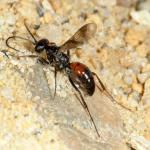A medium-sized species with red and black gaster; the female with bifasciate wings. Males are easy to identify by the characteristic genital plate. However, females can be very difficult to identify and the advice of Day (1988), that some individuals cannot be placed to species, should be heeded.
South-east and central England with a few scattered records further north to Yorkshire and Lincolnshire. Not recorded from the Channel Islands.
It occurs in northern and central Europe (Wolf, 1972). France, Belgium, Netherlands, Luxembourg, Italy, Switzerland, Germany, Denmark, Austria, Czech Republic, Slovakia, Romania, Belarus and Finland (Wahis, 2011).
This species was listed in the Red Data Book (Shirt, 1987) as Rare (RDB3), a status revised to Notable B (now known as Nationally Scarce Nb) in Falk (1991). Current data suggest that it remains scarce but is probably not threatened.
A species of open woodland, particularly on clay.
It flies relatively late in the year, from July to September.
There is little data available. Day (1988) cites an example taken with an immature gnaphosid spider. Chambers (1944) records an immature Clubiona (Clubionidae).
Unknown. Related species are fossorial, often nesting in pre-existing cavities and making
multilocular nests.
No data available. Related species frequent umbels such as wild carrot and hogweed.
2012


